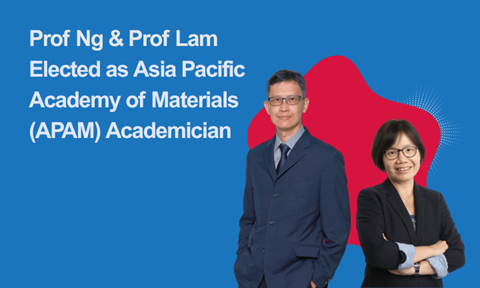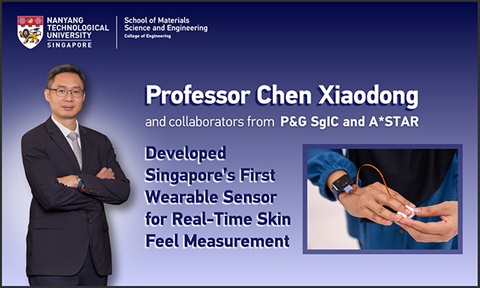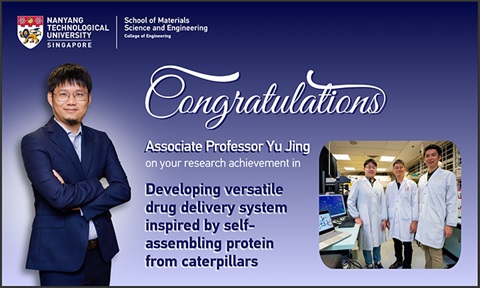"Lego-like" Universal Connector Makes Assembling Stretchable Devices A Snap - Prof Chen Xiaodong
We are pleased to share that Professor Chen Xiaodong and his team have been featured in the news for their research on developing a universal connector that assembles stretchable devices simply and quickly in a "Lego-like" manner.
They have developed a universal connector called BIND (biphasic, nano-dispersed interface), which makes the assembly of stretchable devices simple while offering excellent mechanical
and electrical performance. Like building structures with Lego bricks, high-performing stretchable devices can be assembled by simply pressing together any module bearing the BIND interface. This innovation addresses the long-standing challenge in
making easily assembled stretchable devices without compromising their strength and reliability under stress.
In their experiments, modules joined by BIND were able to withstand stretching up to 7 times their original length before breaking. Moreover, the electrical transmission of modules remained robust up to
2.8 times its original length when stretched. BIND was also evaluated for its interfacial toughness using a standard Peel Adhesion Test, in which the adhesive strength between two modules is tested by
pulling it apart at a constant speed. For encapsulation modules, researchers found the innovation to be 60 times tougher than conventional connectors.
Their technology has already been successfully tested in monitoring devices attached to rat and human skin, measuring the electrical activity of arm muscles even underwater in the latter.
"Our breakthrough innovation makes it very easy to form and use a stretchable device since it works like a ‘universal connector’. Any electronic module bearing the BIND interface can be connected simply by pressing them together for less than 10 seconds. Moreover, we do away with the cumbersome process of building customised interfaces for specific systems, which we believe will help accelerate the development of stretchable devices" - Professor Chen Xiaodong – |

A paper on the breakthrough, which involved Professor Bao Zhenan (Stanford University) and Professor Liu Zhiyuan (Shenzhen Institute of Advanced Technology, Chinese Academy of Science), was published in Nature titled
"A universal interface for plug-and-play assembly of stretchable devices".
Abstract
Stretchable hybrid devices have enabled high-fidelity implantable1,2,3 and on-skin4,5,6 monitoring of physiological signals. These devices typically contain soft modules that match the mechanical requirements in humans7,
8 and soft robots9,10,
rigid modules containing Si-based microelectronics11,12 and protective encapsulation modules13,14. To make such a system mechanically compliant, the interconnects between the modules need to tolerate stress concentration that may limit their stretching and ultimately cause debonding failure
15,16,17.
Here, we report a universal interface that can reliably connect soft, rigid and encapsulation modules together to form robust and highly stretchable devices in a plug-and-play manner. The interface, consisting of interpenetrating polymer
and metal nanostructures, connects modules by simply pressing without using pastes. Its formation is depicted by a biphasic network growth model. Soft–soft modules joined by this interface achieved 600% and 180% mechanical and electrical
stretchability, respectively. Soft and rigid modules can also be electrically connected using the above interface. Encapsulation on soft modules with this interface is strongly adhesive with an interfacial toughness of 0.24 N mm−1.
As a proof of concept, we use this interface to assemble stretchable devices for in vivo neuromodulation and on-skin electromyography, with high signal quality and mechanical resistance. We expect such a plug-and-play interface to simplify
and accelerate the development of on-skin and implantable stretchable devices.

The research article can be found via the link here: https://www.nature.com/articles/s41586-022-05579-z
A summary of the research (Nature Research Briefing) is also available here: https://www.nature.com/articles/d41586-023-00161-7
About Nature
Nature is a weekly international journal publishing the finest peer-reviewed research in all fields of science and technology on the basis of its originality, importance, interdisciplinary interest, timeliness, accessibility, elegance and surprising conclusions. Nature also provides rapid, authoritative, insightful and arresting news and interpretation of topical and coming trends affecting science, scientists and the wider public. The journal has a 2021 impact factor of 69.504.
Our heartiest congratulations to Prof Chen and his team on this excellent achievement!
Media coverage:
- NTU News Release
- The Engineer (UK)
- Semiconductor Digest
- Pioneer Newz
- Ninety News
- News 7F
- Nafa News
- Lucid News
- Its247news (US)
- Greenly News
- The Florida Sun
- Buckeye Review
- AZO Materials
- New Atlas (US)
- CNBeta (Taiwan)
- Hackster.io (US)
- Studyfinds (US)
- NewsWise (US)
- Scienmag (UK)
- Bioengineer (UK)
- Newsbit (US)
- News Update (UK)
- Tech Xplore (US)
- Mirage News (Australia)
- New Electronics (UK)
- HospiMedica (UK)
- 163.com (China)
- Home.China
- China Hightech






.tmb-listing.jpg?Culture=en&sfvrsn=3f725dd6_1)
